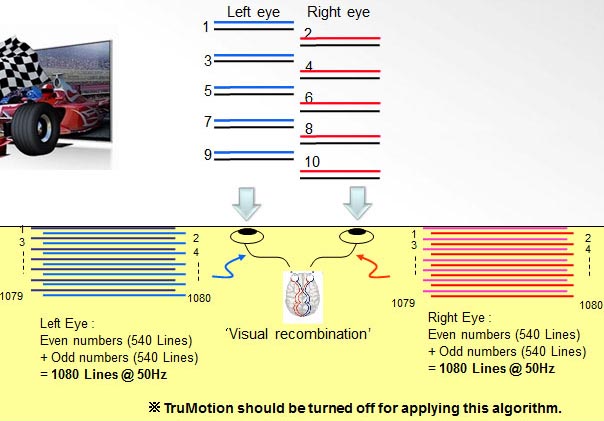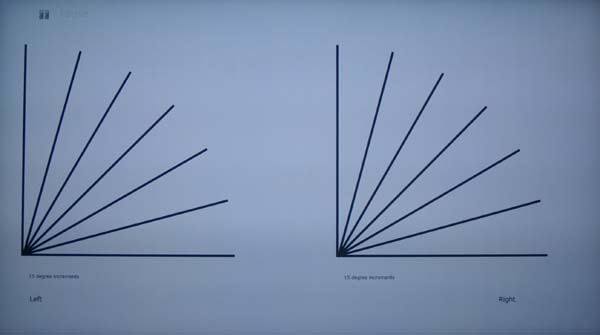So far we’ve established that at least at one point last year Toshiba and LG passive 3D TVs worked by eliminating all the even lines from both eye views, and showing you only the odd numbered lines, shifting the right-hand lines down by one.
But since then LG at least has changed the way it operates. While I go into it in some depth here, it’s worth repeating what LG had to say about the matter, along with its graphic:
Before the Cinema 3D technology worked like this: During a time period of 1/200 seconds the TV showed 2 frames; 540 lines for the left eye and 540 lines for the right eye. The new algorithm shows 4 frames instead of 2 during the 1/200 second time frame. It shows 1080i for the left eye and 1080i for the right eye.
When these are combined the two pictures create a 1080p picture according to LG. LG believes that this update improves picture quality on their Cinema 3D TVs to compete directly with the active 3D TVs such as 3D plasma TVs. You need to turn off TruMotion to utilize the new algorithm. See the illustration below.
I felt that I had pretty much confirmed this using special test patterns that I created with different colours on each line. I also felt I had established fairly well that this would still result in jaggies.
To put it in the terms I’ve been using these last few posts, LG had shifted to a Both Line Allocation system.
But then I created a different test pattern, and this gave completely different results. The pattern was 1,920 x 1,080 pixels, of course, and fed out of a Blu-ray player at 1080p to the TV. Here’s the pattern, photographed from the screen:
The diagonals on the left and right halves of this are identical and if the screen is cut in half and one laid over the other, they are a pixel-perfect match. All that is to allow them to be displayed using the side-by-side 3D method.
And, indeed, here they are. I photographed the screen in this mode without 3D glasses:
The side-by-side 3D mode cuts the picture into equal left and right halves
, doubles the horizontal width of each of them and allocates them to the left and right eyes. Since no 3D glasses were in use, what we see here are both eye views at the same time.
Now let’s zoom in. Here I present a closeup of this pattern, processed into 3D using LG’s side-by-side system. The top part is through the right lens of a pair of 3D glasses, while the bottom part is without using the glasses:
Ignore the colour differences. The polarisation does strange things.
In the top half — viewed through just one lens of the glasses — we see the expected jaggies of course. Remember, with this view half the lines are missing.
But in the bottom half, there are no jaggies. It is clear that every single pixel is present.
This would not be the case if Both Line Allocation would be in effect. Nor if it were Same Line Allocation. The only way it would be this smooth is if it were Alternate Line Allocation, which I’ve described as:
Alternate Line Allocation: With this the display throws out L2, L4 … L1080, and also throws out R1, R3 … R1079. Thus there is no shifting. With your left eye you see only odd numbered lines in their correct placement on the odd numbered display lines. Likewise with your right eye you see only even numbered lines, correctly placed on their even numbered display lines. So all lines that you see are in their correct places on the display. But, of course, half the lines are missing.
The reason you don’t see jaggies is because the odd display lines are getting their content from the odd source lines, the even display lines are getting their stuff from the even source lines, and even lines in both eye views are identical to each other, as are the odd lines.
So we have one set of test patterns suggesting Both Line Allocation and one suggesting Alternate Line Allocation.
Same TV (LG 55LM9600), most recent firmware (Ver.03.01.05), apparently different modes of operation.
Which, of course, leaves me puzzled. Does the TV analyse the content and apply different strategies depending on what the content is? That’s the only thing I can think of which would explain this inconsistent behaviour. Perhaps it looks for hard edges aligned between the two eye views and slips onto Alternate Line Allocation based on that?
For now, I shall just invite comment from those who know far more about this stuff than me.





4 Responses to Passive 3D from the beginning – Part 4 – So how does LG work now?